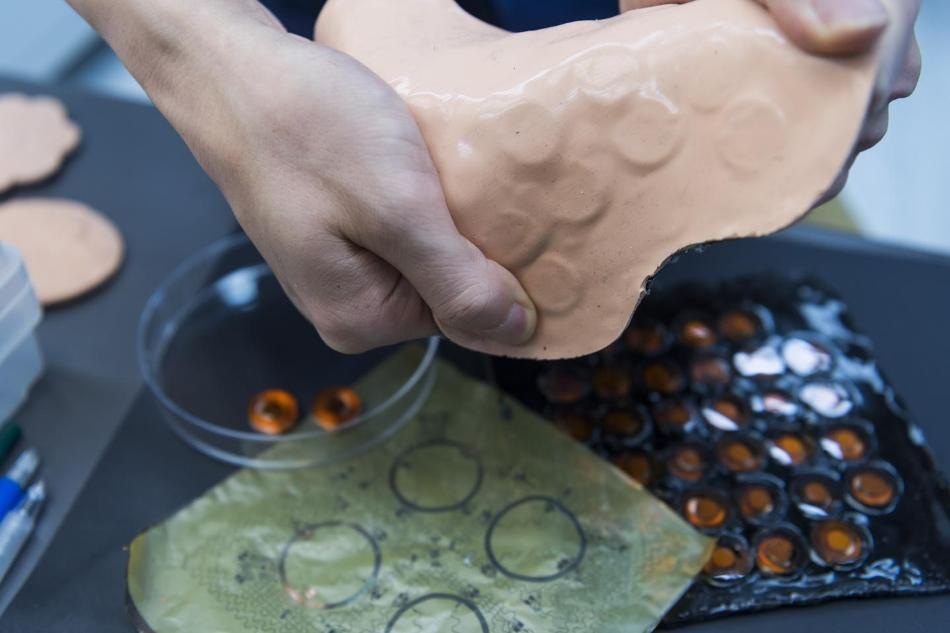Nov 22 2019
A hug from a friend through a video call could soon be sensed in reality. A collaborative research group with engineers and researchers from City University of Hong Kong (CityU) and Northwestern University in the United States has created a skin-integrated virtual reality (VR) system that can be wirelessly powered and controlled.
 Functional components were integrated into a thin elastomeric layer with a thickness of only 3 mm. A total of 32 haptic actuators are controlled in 4 groups, by 8 independently controllable communication ports in the device. Image Credit: City University of Hong Kong.
Functional components were integrated into a thin elastomeric layer with a thickness of only 3 mm. A total of 32 haptic actuators are controlled in 4 groups, by 8 independently controllable communication ports in the device. Image Credit: City University of Hong Kong.
The breakthrough could find wider applications in communications, rehabilitation, and prosthetic control, in addition to gaming and entertainment.
The largest organ in the human body is skin. However, when compared to the eyes and ears, it is an under-explored sensory interface for VR or augmented reality (AR) technology.
Currently, VR and AR devices are generally dependent on vibratory actuation that electrical motors impart to the skin. However, it involves the use of battery packs and bulky wires attached to the body, restricting its applications.
Simulating Touch by Millimeter-Scale Vibration
Dr Yu Xinge, Assistant Professor and Dr Xie Zhaoqian, Senior Research Fellow of Department of Biomedical Engineering at CityU and their colleagues have collaborated with the team from Northwestern University, as well as researchers from various research institutes and companies in the United States and mainland China, and created an integrated skin VR system that can wirelessly receive commands, and then simulate the “touch” with vibration, solving the aforementioned drawbacks.
The user can easily sense the touch by placing a bandage-like soft, thin, and adhesive device on the skin. The study outcomes have been reported in an article titled “Skin-Integrated Wireless Haptic Interfaces for Virtual and Augmented Reality,” published in the most recent issue of the highly prestigious scientific journal Nature.
This innovative skin-integrated VR device has been meticulously designed based on structural mechanics and includes hundreds of functional components, such as the actuators that simulate touch by millimeter-scale mechanical vibration.
These components are combined into a thin silicone-coated elastomeric layer that has a thickness of just 3 mm. It is reusable, breathable, and functional at a complete range of twisting and bending motions.
Wireless-Controlled and Power Efficient
Most significantly, a set of chip-scale integrated circuits and antennae integrated within the skin VR device enables it to be controlled and powered wirelessly.
The haptic actuators can harvest radio frequency power through the large flexible antenna within a certain distance, so the user wearing the device can move freely without the trouble of wires.
Dr Yu Xinge, Assistant Professor, Department of Biomedical Engineering, City University of Hong Kong
It is possible to operate the system within a distance of about 1 m, which is 10 times of current maximum distance using analogous technologies.
The new system uses sophisticated mechanical design, hence the haptic actuators need <2 mW to actuate a notable sensory vibration. By contrast, the traditional direct-current-driven ones require about 100 mW to induce the same level of vibration.
Thus, we solved the difficult problem of transmission by low-power wireless function and significantly increased the distance of the operation for our system. This system not only saves power but also allows users to move more freely without the trouble of wires.
Dr Yu Xinge, Assistant Professor, Department of Biomedical Engineering, City University of Hong Kong
Wide Application Potential
The researchers have spent nearly two years to create this wireless skin VR system, with contributions from different disciplines such as materials science, mechanical engineering, physics, chemistry, and biomedicine. They are running application trial for those who use prostheses to feel the outside environment through the sense of touch and offer feedback to the users.
It can help them to feel the external stimulation with their prosthesis, such as the shape or texture of an object.
Dr Yu Xinge, Assistant Professor, Department of Biomedical Engineering, City University of Hong Kong
Moreover, the system can be used to create virtual scenes for clinical applications. He also considers the system could considerably improve sensory experience in multimedia entertainment, social media interactions, surgical training, and much more.
The next step of the study to develop an electronic skin that can feel temperature.
The corresponding authors of the study are Professor Huang Yonggang and Professor John A. Rogers from McCormick School of Engineering, Northwestern University. The first authors of the study are Dr Yu Xinge and Dr Xie Zhaoqian. Research team members from CityU included Dr Li Dengfeng and Mr Liu Yiming, both also from the Department of Biomedical Engineering.
The research team members also included researchers from the University of Illinois at Urbana-Champaign, Pennsylvania State University, and the University of Arizona in the United States; University of Bristol in the United Kingdom; and Tsinghua University and Shandong University in China.
The study was supported by CityU, the Center for Bio-Integrated Electronics at Northwestern University, National Natural Science Foundation of China, Engineering and Physical Sciences Research Council, China Scholarship Council, and National Basic Research Program of China. The patent of the technology is pending in the United States.